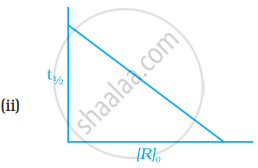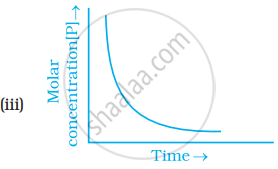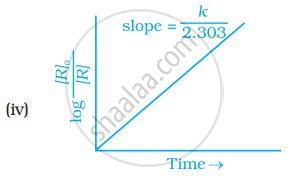Advertisements
Advertisements
प्रश्न
The following data were obtained during the first order thermal decomposition of SO2Cl2 at a constant volume.
\[\ce{SO2Cl2_{(g)} -> SO2_{(g)} + Cl2_{(g)}}\]
| Experiment | Time/s–1 | Total pressure/atm |
| 1 | 0 | 0.5 |
| 2 | 100 | 0.6 |
Calculate the rate of the reaction when total pressure is 0.65 atm.
उत्तर
The thermal decomposition of SO2Cl2 at a constant volume is represented by the following equation.
\[\ce{SO2Cl2_{(g)} -> SO2_{(g)} + Cl2_{(g)}}\]
| At t = 0 | P0 | 0 | 0 |
| At t = t | P0 − p | p | p |
After time t, total pressure, Pt = (P0 − p) + p + p
⇒ Pt = (P0 + p)
⇒ p = Pt − P0
∴ P0 − p = P0 − (Pt − P0)
= 2 P0 − Pt
For a first order reaction,
k = `2.303/"t" log "P"_0/("P"_0 - "p")`
When t = 100 s, k = `2.303/(100s)log 0.5/(2 xx 0.5 - 0.6)`
When Pt = 0.65 atm,
P0 + p = 0.65
⇒ p = 0.65 − P0
= 0.65 − 0.5
= 0.15 atm
∴ When the total pressure is 0.65 atm, pressure of SOCl2 is \[\ce{P_{SO_2Cl_2}}\] = P0 − p
= 0.5 − 0.15
= 0.35 atm
∴ The rate of equation, when total pressure is 0.65 atm, is given by,
Rate = \[\ce{k(P_{SO_2Cl_2)}}\]
= (2.23 × 10−3 s−1) × (0.35 atm)
= 7.8 × 10−4 atm s−1
APPEARS IN
संबंधित प्रश्न
In a pseudo first order hydrolysis of ester in water, the following results were obtained:
| t/s | 0 | 30 | 60 | 90 |
| [A]/mol L−1 | 0.55 | 0.31 | 0.17 | 0.085 |
Calculate the average rate of reaction between the time interval 30 to 60 seconds.
The rate constant for a first order reaction is 60 s−1. How much time will it take to reduce the initial concentration of the reactant to its `1/16`th value?
Following data are obtained for reaction :
N2O5 → 2NO2 + 1/2O2
| t/s | 0 | 300 | 600 |
| [N2O5]/mol L–1 | 1.6 × 10-2 | 0.8 × 10–2 | 0.4 × 10–2 |
1) Show that it follows first order reaction.
2) Calculate the half-life.
(Given log 2 = 0.3010, log 4 = 0.6021)
Define order of reaction. How does order of a reaction differ from molecularity for a complex reaction?
A first order reaction is 50% completed in 1.26 × 1014 s. How much time would it take for 100% completion?
Which of the following graphs is correct for a first order reaction?




State a condition under which a bimolecular reaction is kinetically first order reaction.
With the help of an example explain what is meant by pseudo first order reaction.
The rate constant of a first order reaction is 6.9 × 10–3s–1. How much time will it take to reduce the initial concentration to its 1/8th value?
A first order reaction is 50% complete in 20 minute What is rate constant?
In the first order reaction, half of the reaction is complete in 100 seconds. The time for 99% of the reaction to occurs will be
The reaction X → product
Follow first order of kinetics. In 40 minutes the concentration of 'X' changes from 0.1 m to 0.025. M. The rate of reaction when concentration of X is 0.01 m is.
The decomposition of formic acid on gold surface follows first-order kinetics. If the rate constant at 300 K is 1.0 × 10−3 s−1 and the activation energy Ea = 11.488 kJ mol−1, the rate constant at 200 K is ______ × 10−5 s−1. (Round off to the Nearest Integer)
(Given R = 8.314 J mol−1 K−1)
For a first order reaction, the ratio of the time for 75% completion of a reaction to the time for 50% completion is ______. (Integer answer)
Slove: \[\ce{2NOBr -> 2NO_{2(g)} + Br_{2(g)}}\]
For the above reaction, the rate law is rate = k[NOBr]2. If the rate of reaction is 6.5 × 10−6 mol L−1 s−1 at 2 × 10−3 mol L−1 concentration of NOBr, calculate the rate constant k for the reaction.
The rate constant for the reaction:
\[\ce{2N2O_{(s)} ->2N2O4_{(g)}}\] is 4.98 × 10-4 s-1.
The order of the reaction is ______.
Write the equation for integrated rate law for a first order reaction.
Show that `t_(1/2)= 0.693/k` for first reaction.
